explain what is meant by 3d artistic drawing
An engineering cartoon is a subcategory of technical drawings. The purpose is to convey all the information necessary for manufacturing a production or a function.
Engineering drawings use standardised language and symbols. This makes understanding the drawings simple with fiddling to no personal interpretation possibilities.
So let's look at the different line and view types yous volition run into in the applied science discipline.
The Purpose of Engineering Drawings
As already said, such a technical drawing has all the information for manufacturing a part or welding and edifice an assembly. The info includes dimensions, role names and numbers, etc. So once a manufacturing engineer gets the cartoon, he can start the production process without a second thought.
Beginning, nosotros have to pause for a second and address our own customers here to avert confusion. The drawings you submit for instant pricing and manufacturing in our system do not need any of this. The same applies to 3D models. CAD files and drawings fabricated according to our pattern tips include all the necessary information for making your production. The only fourth dimension nosotros ask for a cartoon is if yous desire to specify tolerances.
Nevertheless, knowing all the rules and nuts of formatting is an accented must in the industry, as traditional manufacturing companies still need detailed drawings.
How to Make Drawings?
A few decades agone, yous would have had to sit down at a drawing board covered with papers of dissimilar size, rulers, callipers, etc. Today, all these instruments are still adept for manual drafting but no contemporary manufacturer really wants such drawings.
Why? Because most of the mechanism uses CNC systems that can read the information straight from the files and produce a cutting program appropriately. Drawings done past hand would just add a lot of transmission work for manufacturing engineers.
And so, we are left with merely one option really – every engineer should use CAD (computer aided pattern) software because of its many advantages.
Y'all tin, of course, apply CAD for making drawings from scratch. Simply the easier option is to first brand a 3D model and create the drawings from that, as the programs generate the views with only a few clicks. All you need to do is add the dimensions. Having models also makes updating the drawings for revisions simple.
Basic Components of an Engineering Cartoon
Let's come across what makes up an applied science drawing. A single drawing includes many elements with quite a few variations to each of them. And then let'due south take a closer look here.
Different Types of Lines
Not every line on an technology drawing is equal. The different options make information technology possible to show both visible and hidden edges of a part, heart lines, etc.

The most common is a continuous line, too known as a drawing line. This represents the physical boundaries of an object. Put but, these lines are for cartoon the objects. The line thickness varies – the outer contour uses thicker lines and inner lines are thinner.

Hidden lines can prove something that would not exist otherwise visible on the drawings. For example, hidden lines may show the length of an internal pace in a turned function without using a section or a cutout view (nosotros explicate both later).

Centre lines are used to show pigsty and the symmetric properties of parts. Showing symmetricity tin reduce the number of dimensions and make the cartoon more eye-pleasing, thus easier to read.

Extension lines comment what is being measured. The dimension line has two arrowheads between the extension lines and the measurement on top (or inside, like in the image in a higher place) the line.

Break lines indicate that a view has been broken. If you accept a part that is 3000 mm long and 10 mm wide with symmetric properties, using a pause-out makes gives all the info without using every bit much space.
While a practiced manner for giving information to people, CNC machines demand full views in society to cut the parts. Otherwise, the manufacturing engineer has to reconstruct the whole part from the measurements.
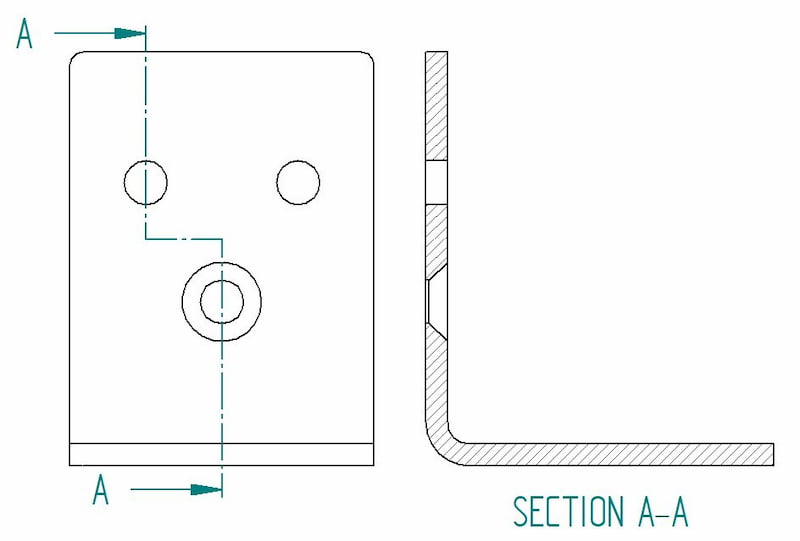
When using a cutout view, the cut plane lines show the trajectory of the cutout. Here you tin can run across that the A-A cutting line brings both types of holes into the view.
Types of Views
So let'south take a closer expect at the different types of views that are often nowadays in a manufacturing cartoon. Each serves a certain purpose. Deport in heed that adding views should follow the same logic as dimensioning – include every bit piffling as possible and every bit much as necessary.
A tip for good engineering practice – merely include a view if it contributes to the overall understanding of the design.
Isometric View
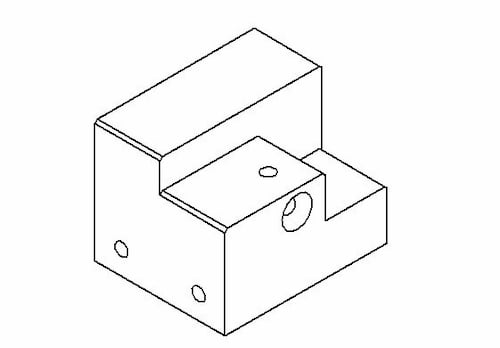
Isometric drawings show parts equally three-dimensional. All the vertical lines stay vertical (compared to front end view) and otherwise parallel lines are shown on a 30-caste angle.
The lines that are vertical and parallel are in their truthful length. Which means you tin use a ruler and the scaling of the cartoon to easily measure the length direct from a newspaper drawing, for example. The same does not apply to angled lines.
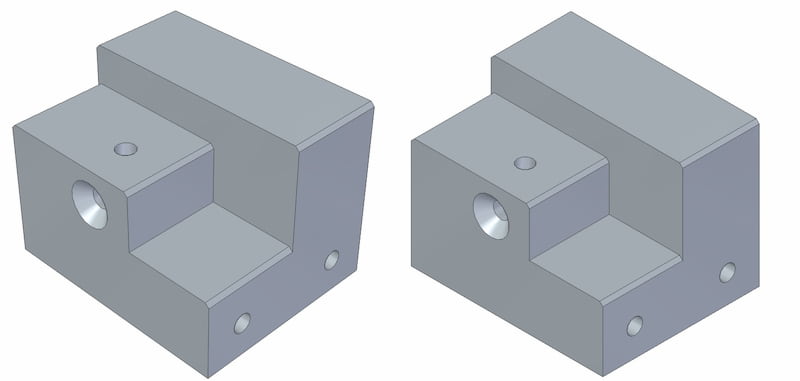
It is important to distinguish the isometric view from a perspective view. A perspective view is an artistic ane that represents an object equally it seems to the eye. Engineers stay truthful to the dimensions rather than optical illusions.
Orthographic View
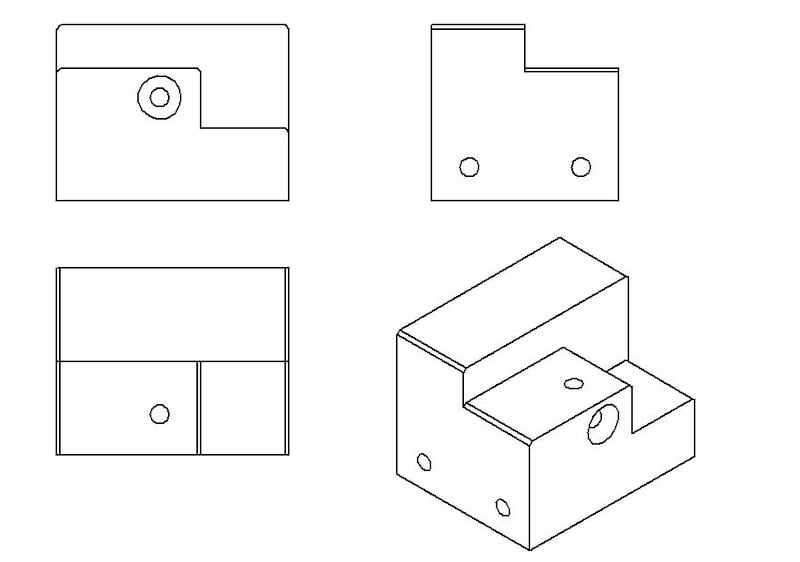
This is the staff of life and butter of an technology cartoon. An orthographic view or orthographic projection is a fashion of representing a 3D object in 2 dimensions.
Thus, a 2d view has to convey everything necessary for part product. This kind of representation allows avoiding whatsoever kind of distortion of lengths.
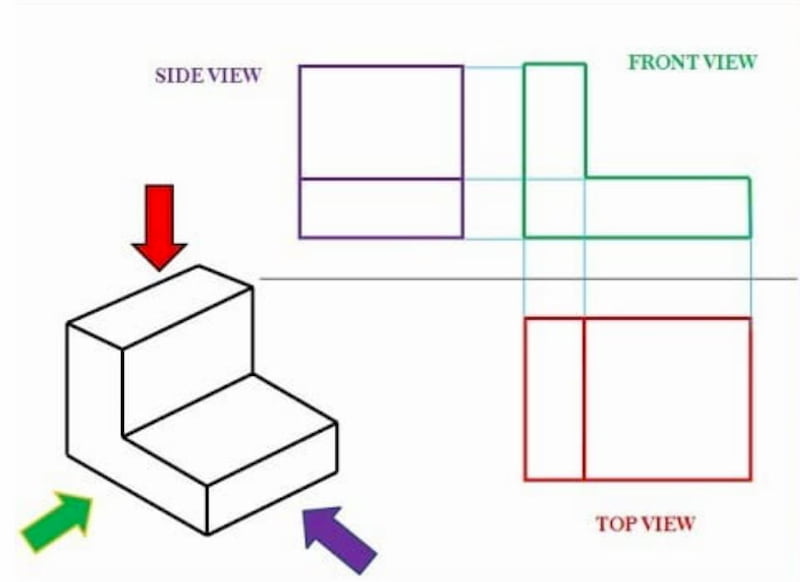
The nigh common way to communicate all the information is by using three different views in a multiview cartoon:
- Front view
- Top view
- Side view
Information technology may be possible that some additional views are necessary to show all the info. Just again, less is more than.
The positioning of the views differs a fleck regionally. For example, look at the paradigm below to compare the US and ISO layouts.

The i on the left is called first-bending projection. Here, the top view is nether the forepart view, the right view is at the left of the forepart view, etc. The ISO standard is primarily used in Europe.
On the correct, you can see a third-angle projection. The right view is on the correct, top view on the acme of the front view, etc. This organization is peculiarly pop in the The states and Canada.
Flat Blueprint
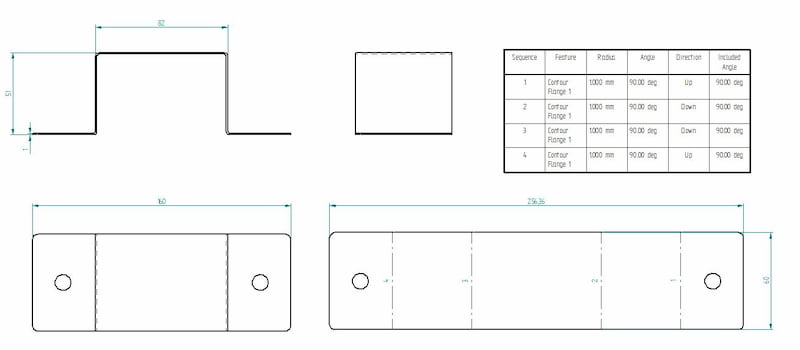
If yous are making a folded canvass metal part, do non forget to add a apartment design view. The cutting task comes before bending. When information technology comes to our customers, the easiest manner is only to upload a STEP file without any accompanying drawings.
Creating a flat blueprint view is usually pretty simple. Just exist aware that yous are using the sheet metal environment when making sheet metal parts in CAD. There yous accept the selection to "generate a apartment blueprint" which you can easily add to the chief cartoon.
If you are using the standard part environs, the same option is not available. Still, many CAD programs have the possibility to catechumen a standard part into sheet metal if the function properties correspond to canvass metal (e.thousand. uniform thickness, inside radius, etc.).
Section View

A section view can easily display some of the part features that are not evident when looking only from the commencement. Cross department is the preferred choice compared to hidden lines as it brings more clarity. The cross hatching feature is and indicator for cantankerous sectional views.
Cutout View

This is the same paradigm we used for illustrating the department view. With ane slight difference – the side view includes cutouts. Cutouts can reduce the number of unlike views on a unmarried cartoon.
Thus, we could hands delete the section view and add all the necessary dimensions to cutouts.
Detail View
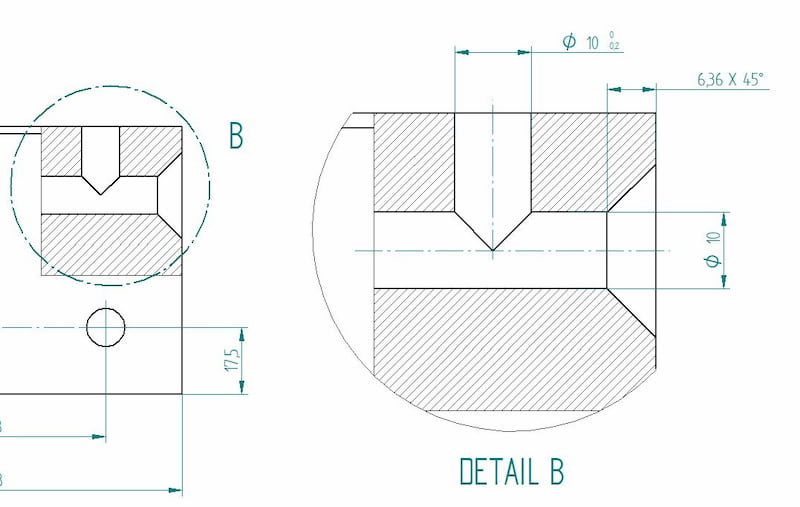
The detail view gives us a close-up of a selected section of a larger view. This can be especially useful if an otherwise large function includes many important dimension in a small area. Using the detail view improves the readability of these measurements.
Auxiliary View
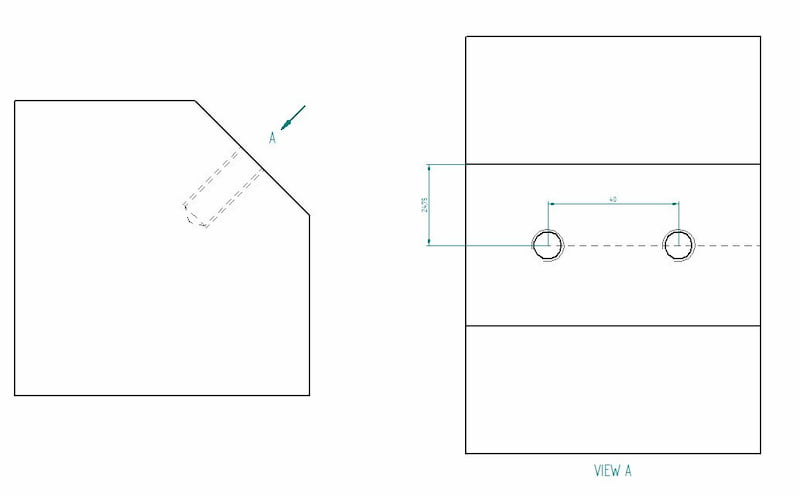
An orthographic view to represent planes that are not horizontal or vertical. It helps to show inclined surfaces without any distortion.
Dimensions
Equally said before, new CNC machines are actually able to read the dimensions straight from the lines. But a traditional manufacturing drawing shows all the necessary dimensions for producing the parts.
The keyword here is necessary. Avoid using the car-dimensioning feature that a lot of CAD programs offering because they tend to show everything they tin can find. For a beginner, it may seem like adding it all ensures that no mistakes can be made.
Actually, it can result in a confusing web of measurements that is left for the manufacturing engineer to untangle. Also, adding all dimensions you can find makes it hard to pinpoint which ones are the most important.
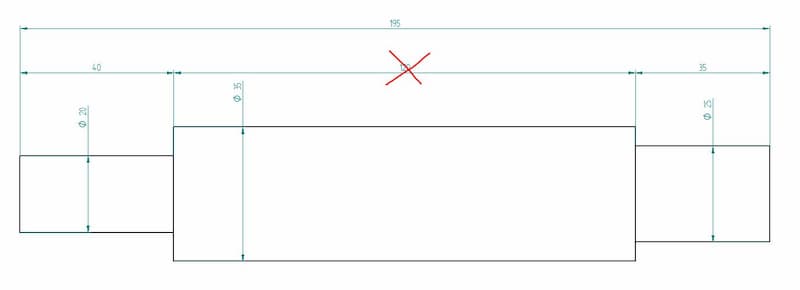
The image above shows a shaft with all the measurements. In reality, it creates a closed system whereby the manufacturer cannot guarantee all these dimensions 100%. Therefore, you take to make up one's mind the about important ones. In our case, nosotros chose the finish steps to be more of import than the length of the central part. Thus, nosotros should delete the 120 mm dimension.
1 crucial chip of information that is missing from CAD models is geometric dimensioning and tolerancing (GD & T). For case, when looking to produce a shaft for a bearing organisation, limits and fits are of loftier importance. The correct dimensions can guarantee a longer lifetime with less maintenance.
While you can fetch all the dimensions automatically by clicking the measure push button, adding engineering science tolerances needs manual activity.
Therefore, adding dimensions with lower and upper limits or fit classes is still important. Regarding Fractory's service, we would ask you to enclose a separate drawing with these parameters. Annotation that you do non have to provide the whole dimensioning – merely include the tolerances of a single hole on your engineering drawings if necessary.
Information Blocks
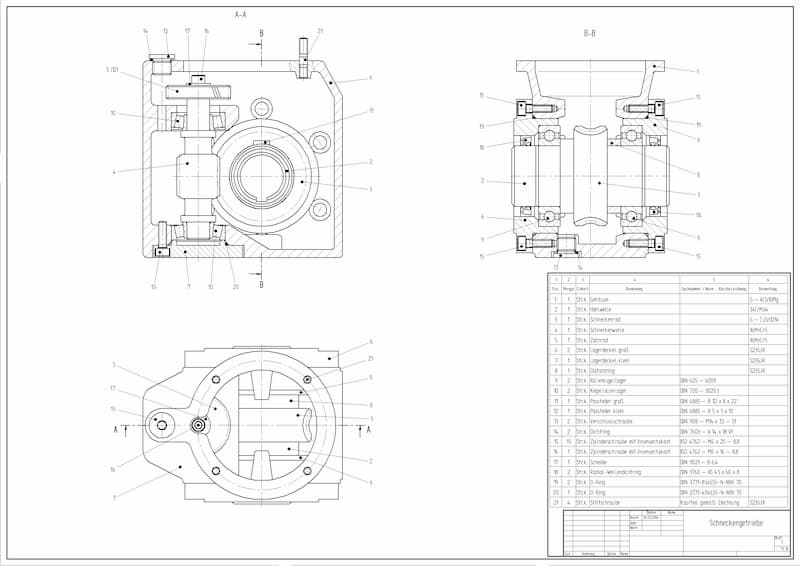
The trivial boxes in the bottom right corner show additional information. The title cake includes the writer'due south name, part name, office number, quantity, coating, scale, etc. At that place can be much more info on there but the title blocks vary widely between unlike companies.
Data blocks as well include a neb of materials, or BOM for short. These blocks list all the components used in the associates, along with additional information like quantities, part names, etc.
Associates Drawings
Many engineers' drawings make the mistake of trying to include all the information about each individual part in an assembly drawing. To avoid this, think the purpose of these applied science drawings during the cosmos process – they must make the assembling easy.
Exploded views, section views, numbered parts, general dimensions, cutouts, detail views (or close-ups) are all tools you tin can use to reach this goal.
Information technology should be articulate where each office goes and how information technology is attached – whether it needs welding, bolted connections, riveting or something else. The bill of materials is in that location to help you, then brand sure the information available there is correct regarding part numbers, names and quantities.
Keeping everything above in mind will help yous create assembly drawings that make life easier on the store flooring. A piece of keen advice I once received goes similar this – keep the thinking in the drawing-room. Fugitive multiple interpretation possibilities at later steps will significantly decrease the number of errors.
What Does the Future Hold?
Engineering drawings are still a big function of an engineer'southward job. All in all, making them contributes to almost 20% of a design engineer'south work time.
We at Fractory are trying to relieve this time by automating the reading of 3D models for production. This leaves engineers with the task of producing assembly and GD&T drawings only. The purpose is to continue the focus on technology improve products.
The engineering community is seeing this movement as a new trend. Only every bit we all know, taking the whole industry up to a new standard takes a lot of time. Thus, if y'all notwithstanding outsource your production to manufacturing companies who need drawings, you must know the nuts at the very least.
Leaving room for interpretation creates a situation where your idea may not be executed as planned. And at that place is nobody else to blame merely the writer.
So consider this phase of the product development procedure as an integral part that requires thinking forth. Keep the thinking in the cartoon-room.
Source: https://fractory.com/engineering-drawing-basics/
0 Response to "explain what is meant by 3d artistic drawing"
Post a Comment